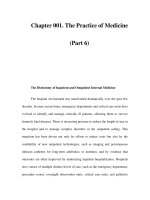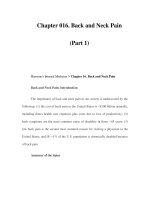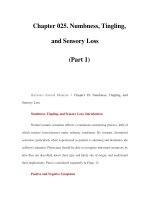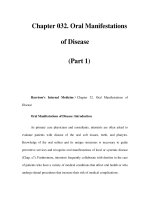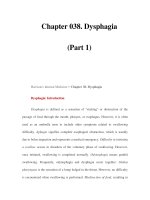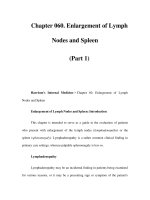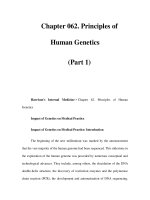Chapter 074. Biology of Obesity (Part 1) ppsx
Bạn đang xem bản rút gọn của tài liệu. Xem và tải ngay bản đầy đủ của tài liệu tại đây (70.17 KB, 5 trang )
Chapter 074. Biology of Obesity
(Part 1)
Harrison's Internal Medicine > Chapter 74. Biology of Obesity
Biology of Obesity: Introduction
In a world where food supplies are intermittent, the ability to store energy
in excess of what is required for immediate use is essential for survival. Fat cells,
residing within widely distributed adipose tissue depots, are adapted to store
excess energy efficiently as triglyceride and, when needed, to release stored
energy as free fatty acids for use at other sites. This physiologic system,
orchestrated through endocrine and neural pathways, permits humans to survive
starvation for as long as several months. However, in the presence of nutritional
abundance and a sedentary lifestyle, and influenced importantly by genetic
endowment, this system increases adipose energy stores and produces adverse
health consequences.
Definition and Measurement
Obesity is a state of excess adipose tissue mass. Although often viewed as
equivalent to increased body weight, this need not be the case—lean but very
muscular individuals may be overweight by numerical standards without having
increased adiposity. Body weights are distributed continuously in populations, so
that choice of a medically meaningful distinction between lean and obese is
somewhat arbitrary. Obesity is therefore more effectively defined by assessing its
linkage to morbidity or mortality.
Although not a direct measure of adiposity, the most widely used method to
gauge obesity is the body mass index (BMI), which is equal to weight/height
2
(in
kg/m
2
) (Fig. 74-1). Other approaches to quantifying obesity include anthropometry
(skin-fold thickness), densitometry (underwater weighing), CT or MRI, and
electrical impedance. Using data from the Metropolitan Life Tables, BMIs for the
midpoint of all heights and frames among both men and women range from 19–26
kg/m
2
; at a similar BMI, women have more body fat than men. Based on data of
substantial morbidity, a BMI of 30 is most commonly used as a threshold for
obesity in both men and women. Large-scale epidemiologic studies suggest that
all-cause, metabolic, cancer, and cardiovascular morbidity begin to rise (albeit at a
slow rate) when BMIs are ≥25, suggesting that the cut-off for obesity should be
lowered. Most authorities use the term overweight (rather than obese) to describe
individuals with BMIs between 25 and 30. A BMI between 25 and 30 should be
viewed as medically significant and worthy of therapeutic intervention, especially
in the presence of risk factors that are influenced by adiposity, such as
hypertension and glucose intolerance.
Figure 74-1
Nomogram for determining body mass index. To use this nomogram,
place a ruler or other straight edge between the body weight (without clothes) in
kilograms or pounds located on the left-hand line and the height (without shoes) in
centimeters or inches located on the right-hand line. The body mass index is read
from the middle of the scale and is in metric units. (Copyright 1979, George A.
Bray, M.D.; used with permission.)
The distribution of adipose tissue in different anatomic depots also has
substantial implications for morbidity. Specifically, intraabdominal and abdominal
subcutaneous fat have more significance than subcutaneous fat present in the
buttocks and lower extremities. This distinction is most easily made clinically by
determining the waist-to-hip ratio, with a ratio >0.9 in women and >1.0 in men
being abnormal. Many of the most important complications of obesity, such as
insulin resistance, diabetes, hypertension, hyperlipidemia, and hyperandrogenism
in women, are linked more strongly to intraabdominal and/or upper body fat than
to overall adiposity (Chap. 236). The mechanism underlying this association is
unknown but may relate to the fact that intraabdominal adipocytes are more
lipolytically active than those from other depots. Release of free fatty acids into
the portal circulation has adverse metabolic actions, especially on the liver.
Whether adipokines and cytokines secreted by visceral adipocytes play an
additional role in systemic complications of obesity is an area of active
investigation.


